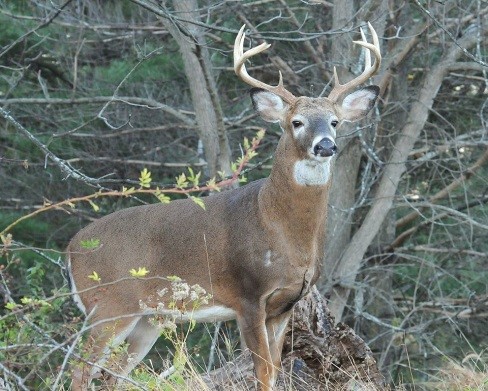|
FOR IMMEDIATE RELEASE |
Contact: Caryn Shinske (609) 984-1795 |
|
DEP's Division of Fish and Wildlife Urges Motorists to Use Caution While Driving as Deer Breeding Season Approaches (16/P96) TRENTON – With the arrival of the fall breeding season, the Department of Environmental Protection’s Division of Fish and Wildlife is reminding motorists to be alert for white-tailed deer, which may unexpectedly dart onto roads and cause accidents. Motorists are urged to be especially attentive and cautious during morning and evening commutes when visibility may be poor. Deer are involved in thousands of collisions annually in New Jersey, with as many as half coming during the fall mating season, or rutting season, which peaks in November. An adult male deer can weigh 150 pounds or more. During rutting season, deer are most active in the very early morning and around sunset, when visibility conditions can be very difficult. This is when bucks are most actively pursuing does. Using caution while driving will become even more important when Daylight Saving Time ends November 6, causing commutes to align with periods when deer are most active. For motorists, low levels of light and sun glare can make it very difficult to see deer that are about to cross the road. Moreover, multiple deer may cross the road at any given moment, usually in a single file. Peak rutting season for deer in New Jersey runs from late October, throughout November, and into mid-December in all areas of the state, beginning earliest in northern regions. Motorists are encouraged to inform the Department of Transportation of dead deer they find along the state highway system, and can share information at http://www.nj.gov/transportation/commuter/potholeform.shtm Municipal and county governments are responsible for removal of dead deer from roads they maintain. The following tips can help motorists stay safe during rutting season:
As a result of New Jersey’s proactive deer management policies, the estimated population of deer in New Jersey, derived from a formula based on deer harvested in hunting seasons, is about 101,000, down from 204,000 in 1995. This does not factor in deer inhabiting areas where hunting is not permitted. The DEP’s Community-Based Deer Management Program is available to help municipalities control deer in areas where sport hunting is not a viable management tool. To hear a new Discover DEP podcast about New Jersey’s deer population, visit: https://urldefense.com/v3/__http://njdep.podbean.com/e/episode-26-deer-rutting-season-with-principal-biologist-dan-roberts__;!!J30X0ZrnC1oQtbA!ereTZ0VnsSe0tQyL6PgIRLx-L3CPpCQohkdBYWju8jZL0AWFg0s4SpIsjB51tUysiI6Vew$ For more information about white-tailed deer in New Jersey, visit: https://urldefense.com/v3/__http://www.njfishandwildlife.com/deer.htm__;!!J30X0ZrnC1oQtbA!ereTZ0VnsSe0tQyL6PgIRLx-L3CPpCQohkdBYWju8jZL0AWFg0s4SpIsjB51tUxawTQGYA$ For more information on the Community-Based Deer Management Program, visit: https://urldefense.com/v3/__http://www.njfishandwildlife.com/cbdmp.htm__;!!J30X0ZrnC1oQtbA!ereTZ0VnsSe0tQyL6PgIRLx-L3CPpCQohkdBYWju8jZL0AWFg0s4SpIsjB51tUxhCF33dQ$ |
|
 “People should always be alert for deer when driving, but especially at this time of year, when deer can suddenly run onto any roadway, from busy highways to country roads,” said Division of Fish and Wildlife Director David Chanda. “One moment of inattentive driving can result in serious or even life-altering consequences.”
“People should always be alert for deer when driving, but especially at this time of year, when deer can suddenly run onto any roadway, from busy highways to country roads,” said Division of Fish and Wildlife Director David Chanda. “One moment of inattentive driving can result in serious or even life-altering consequences.”